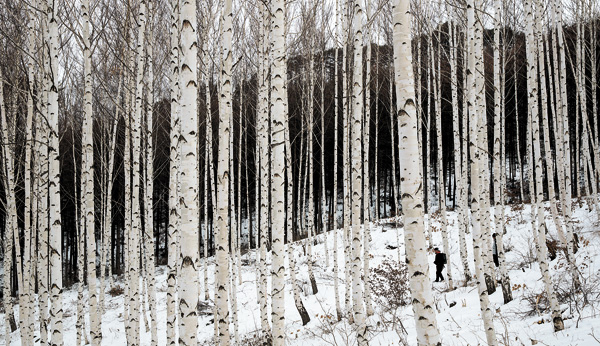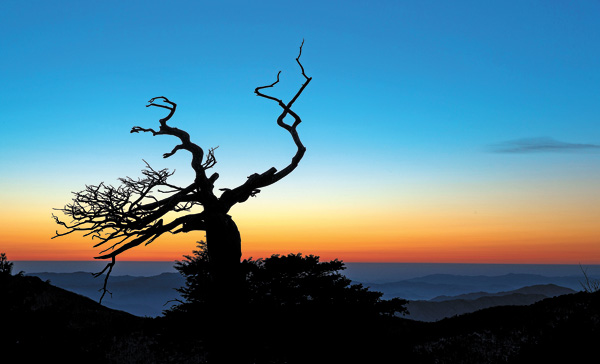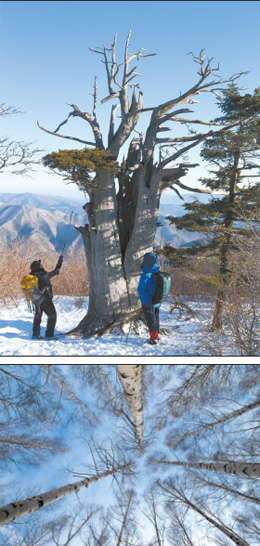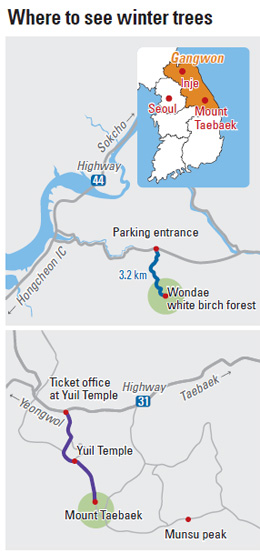Gangwon’s unique trees better seen in winter

A group of white birch trees covered in snow stand on a landscape in Inje County, Gangwon. By Ahn Sung-sik
The mountains may look emptier than in spring when flowers bloom, but the sense of extra space in between the leafless twigs creates a clearer form.
Large groups of white birch and a type of spreading yew that is widely seen in Korea explain why more people are going to Korea’s coldest region to hike, even in subzero weather.
A classic winter wonderland
To get a wholesome wintry feel whether it snows or not, walk into a white birch forest.
The species has pale white bark, which is an exotic sight in Korea, as it is known to grow more abundantly in colder regions such as snowy Siberia.

A dead spreading yew, known as jumok in Korean, with its form intact in Mount Taebaek, Gangwon.
The tree is easily seen in North Korea, however.
Proof of this comes from the poetry penned by renowned writers from the Communist region.
Poet Baek Seok (1912-96), from the North’s Pyeongan Province, wrote that the white birch tree was a large part of his life back in his hometown.
He said wooden doors, floors and pillars are all made with the tree and that people also burn them to make fires and to cook.
Baek even said that the mountains behind his home were filled with the beautiful birches.

Top: The trunk of a dead spreading yew that has a decomposed inside. Above: White birch trees.
About two or three decades ago, local district offices planted white birches in Wondae and Susan in Inje County, as well as in Taebaek and Hoengseong County, Gangwon.
Local offices started to open the areas to the public in the past couple of years.
The largest habitat for the white birch in South Korea is in Wondae.
The Korea Forest Service planted 40,000 trees there in the 1990s to form wooded areas.
And since the area was opened to the public, these forests have been attracting more and more visitors.
Only about 7,850 people visited the area back in 2011, but the number skyrocketed to around 115,000 last year, according to the Inje forest management office, which is operated by the Korea Forest Service.
On weekends, the forest greets around 1,000 people.
It used to close from Nov. 1 to Dec. 15, and from Feb. 1 to May 15 every year, when the moisture level in the air becomes very low, in order to prevent fires.
However, in a bid to have as many people appreciate the view of the groups of trees in winter, the forest will stay open this month.
It has still not been decided whether access to the forests will be granted next month, so interested parties should hurry down to Inje.
You will start to spot the trees after hiking for about an hour into the mountain from the information center. The 3.2-kilometer (two-mile) trek is not too difficult as long as the trail you choose is not steep.
After you reach the entrance to the forest, there are four different trails available.

You could pick up some fallen pieces of bark along your hike because, according to oral tradition, writing on the old wood will help you to find your true love.
There is no entrance fee or parking lot charge for visitors coming through all year long.
For more information, call (033) 460-8031.
Trees that still exist after death
Gangwon is also a destination where you can see the relatively unique spreading yew, a tree that is known to live over 500 years on average and even remains in the same form after death.
Some of these trees have witnessed the highs and lows of Korea’s long history.
The tree received its Korean name jumok as its trunk looks red, even on the inside.
Ju in Korean means red and mok means tree.
“Such a type of tree was able to survive for a long period of time because it lived in the center of deep mountains and that made it much harder for people to spot it and carry it out,” said Oh Jang-geun, manager of the Korea National Park Service’s conservation team.
Oh also has a doctoral degree in plant ecology.
Mount Taebaek is the place to go to see large habitats of such a tree. The mountain, with its altitude of 1,567 meters, is known for having spreading yews on one of its peaks in Jeongseon, Gangwon.
That particular tree has lived for more than 1,400 years on Duwi Peak, ecology experts say.
There are 3,928 spreading yews living on Mount Taebaek. Officials at the Taebaek forest management office who roam the mountain ranges counted each one back in 2009.
The number would easily be more than 4,000 if they were to include the dead spreading yews. The tree is said to be able to live another 1,000 years after it dies.
Even when its trunk is decomposed and looks like it could be pushed over with a hint of wind, it can still grow leaves. It continues to bring new life when it can find the tiniest drop of energy from somewhere inside.
“The tree’s inside is as dense and firm as a rock because it usually grows very slowly from very barren land where there is almost no moisture,” said Oh.
“And because the tree itself is quite dry, it barely decomposes quickly after its death, and that’s how a dead tree can continue to stand still during the times when strong winds hit it.”
The Japanese also recognized the great quality of the wood and cut down the spreading yews grown in Korea in the early 1900s to make Go boards, religious statues and furniture for the country’s high-level government officials. They even tried to grow the trees at home as the red trunk was said to keep evil spirits away.
“It is said that Korea had a lot more spreading yews before, but many Japanese took them away during the Japanese colonial rule,” said Oh.
There are about six different hiking courses in Mount Taebaek. Whichever way you choose, you have to reach higher than an altitude of 1,000 meters to see the red trees. You can spot them near Choego Peak and Janggun Peak, both of which are located more than 1,500 meters above sea level.
But the trees there are mostly dead. To see some of the species that are still alive, head on a trail along the mountain range that is about 3 kilometers long, from Janggun Peak and Munsu Peak.
The shortest course from a ticket office at Yuil Temple into the mountain is about 4 kilometers one way.
The fee to enter is 2,000 won for adults. The trail is relatively easy to walk through, so two hours will be enough to get to Janggun Peak.
However, since most visitors come during wintertime to see a scenic view through the trees, you might want to hurry and head there early in the morning.
Around 30,000 visitors come to the peak per day during the cold weather.
Mount Taebaek is known for snow. Hikers absolutely need to have climbing irons attached to their shoes. Extra warm clothing is also necessary as areas near Janggun Peak usually have strong winds.
For more information, call (033) 550-2741
BY SON MIN-HO, LEE SEOK-HEE [summerlee@joongang.co.kr]










with the Korea JoongAng Daily
To write comments, please log in to one of the accounts.
Standards Board Policy (0/250자)